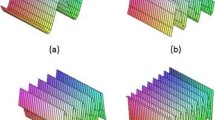Abstract
We provide necessary and sufficient geometric conditions for the exact controllability of the one-dimensional fractional free and fractional harmonic Schrödinger equations. The necessary and sufficient condition for the exact controllability of fractional free Schrödinger equations is derived from the Logvinenko–Sereda theorem and its quantitative version established by Kovrijkine, whereas the one for the exact controllability of fractional harmonic Schrödinger equations is deduced from an infinite dimensional version of the Hautus test for Hermite functions and the Plancherel–Rotach formula.
Similar content being viewed by others
References
P. Alphonse, J. Bernier, Smoothing properties of fractional Ornstein-Uhlenbeck semigroups and null-controllability, preprint (2018), arXiv:1810.02629
K. Beauchard, P. Jaming, K. Pravda-Starov, Spectral inequality for finite combinations of Hermite functions and null-controllability of hypoelliptic quadratic equations, preprint (2018), arXiv:1804.04895
J.-M. Coron, Control and nonlinearity, Mathematical Surveys and Monographs 136, AMS, Providence, RI (2007)
T. Duyckaerts, L. Miller, Resolvent conditions for the control of parabolic equations, J. Funct. Anal. 263 (2012), no. 11, 3641-3673
M. Egidi, I. Veselić, Sharp geometric condition for null-controllability of the heat equation on \(\mathbb{R}^d\) and consistent estimates on the control cost, Arch. Math. (Basel) 111 (2018), no. 1, 85-99
W. Green, B. Jaye, M. Mitkovski, Uncertainty principles associated to sets satisfying the geometric control condition, preprint (2019), arXiv:1912.05077
L. Hörmander, The analysis of linear partial differential Operators. III. Pseudo-differential operators, Reprint of the 1994 edition. Classics in Mathematics. Springer, Berlin (2007)
S. Huang, G. Wang, M. Wang, Observable sets, potentials and Schrödinger equations, preprint (2020), arXiv:2003.11263
A. Koenig, Non-null-controllability of the fractional heat equation and of the Kolmogorov equation, preprint (2018), arXiv:1804.10581v1
O. Kovrijkine, Some results related to the Logvinenko-Sereda Theorem, Proc. Amer. Math. Soc. 129, (2001), no. 10, 3037-3047
J.-L. Lions, Contrôlabilité exacte, perturbations et stabilisation de systèmes distribués, Tome 1 et 2, vol. 8, Recherches en Mathématiques Appliquées, Masson, Paris (1988)
V.N. Logvinenko, J.F. Sereda, Equivalent norms in spaces of entire functions of exponential type, Teor. Funkcii Funkcional. Anal. i Prilozen. Vyp. 20 (1974), 102-111, 175
L. Miller, Resolvent conditions for the control of unitary groups and their approximations, J. Spectr. Theory 2 (2012), no. 1, 1-55
G. Szegö, Orthogonal polynomials, Fourth edition, American Mathematical Society, Colloquium Publications, Vol. XXIII. American Mathematical Society, Providence, R.I. (1975)
G. Wang, M. Wang, C. Zhang, Y. Zhang, Observable set, observability, interpolation inequality and spectral inequality for the heat equation in \(\mathbb{R}^d\), J. Math. Pures Appl. 126 (2019), 144-194
Author information
Authors and Affiliations
Corresponding author
Additional information
Publisher's Note
Springer Nature remains neutral with regard to jurisdictional claims in published maps and institutional affiliations.
Appendix
Appendix
This appendix contains the proof of two instrumental results. The first part is devoted to the proof of a technical lemma used in the proof of Proposition 2.1. The purpose of the second part is to recall the proof of Miller’s result stated in Proposition 1.3.
1.1 A technical lemma
The following technical result is used in the proof of Proposition 2.1:
Lemma 5.1
If A is a measurable subset of \([-\frac{\pi }{2}, \frac{\pi }{2}]\) and \(\delta =|A|\) denotes its Lebesgue measure, then
Proof
By using that the function \(x \mapsto \sin ^2 x\) is even and increasing on \([0,\frac{\pi }{2}]\), we observe that
By using that \(\delta =|A|=|[-\frac{\delta }{2}, \frac{\delta }{2}]|\), we notice that
It follows from (5.1) and (5.2) that
This ends the proof of Lemma 5.1. \(\square \)
1.2 Spectral inequalities and exact controllability
This section is devoted to recall the proof of Miller’s result [13, Corollary 2.17] stated in Proposition 1.3 which provides necessary and sufficient spectral estimates for the observability of system (1.3) to hold. The proof of Proposition 1.3 is based on another Miller’s result [13, Theorem 2.4] characterizing the observability with resolvent conditions which is recalled below and whose proof is omitted:
Proposition 5.2
(Miller [13, Theorem 2.4]). Let \((A,\mathcal {D}(A))\) be a self-adjoint operator on \(L^2(\mathbb {R}^d)\), which is the infinitesimal generator of a strongly continuous group \((e^{itA})_{t \in \mathbb {R}}\) on \(L^2(\mathbb {R}^d)\). The system (1.3) is exactly observable from a measurable subset \(\omega \subset \mathbb {R}^d\) if and only if there exist some positive constants \(M>0\) and \(m>0\) such that
When condition (5.3) is satisfied, exact observability holds in any time \(T > \pi \sqrt{M}\).
We consider the system (1.3). If this system is exactly observable from a measurable subset \(\omega \subset \mathbb {R}^d\) at some time \(T>0\), Proposition 5.2 proves that there exist some positive constants \(M>0\) and \(m>0\) such that the resolvent estimate (5.3) holds. Let \(\lambda \in \mathbb {R}\), \(0< D < \frac{1}{M}\) and \(f \in \mathbb {1}_{\{|A-\lambda | \le \sqrt{D}\}}\big (\mathcal {D}(A)\big )\). The functional calculus shows that
It follows from (5.3) and (5.4) that
that is
It establishes the spectral estimates (1.4) for all \(f \in \mathbb {1}_{\{|A-\lambda | \le \sqrt{D}\}}\big (L^2(\mathbb {R}^d)\big )\) since the domain \(\mathcal {D}(A)\) is dense in \(L^2(\mathbb {R}^d)\).
Conversely, let us assume that there exist some positive constants \(D>0\) and \(k>0\) such that the spectral estimates (1.4) hold. Let \(\lambda \in \mathbb {R}\) and \(f \in \mathcal {D}(A)\). With \(f_{\lambda } = \mathbb {1}_{\{|A-\lambda | \le \sqrt{D} \}} f\) and \(f_{\perp }=f-f_{\lambda }\), we deduce from (1.4) and the functional calculus that for all \(\lambda \in \mathbb {R}\) and \(f \in \mathcal {D}(A)\),
Let \(T> \pi \sqrt{\frac{1+k}{D}}\) and \(\varepsilon >0\) such that
The functional calculus shows that for all \(\lambda \in \mathbb {R}\) and \(f \in \mathcal {D}(A)\),
It follows from (5.6) and (5.7) that
We can deduce from Proposition 5.2 that the system (1.3) is exactly observable from \(\omega \) in time T.
Rights and permissions
About this article
Cite this article
Martin, J., Pravda-Starov, K. Geometric conditions for the exact controllability of fractional free and harmonic Schrödinger equations. J. Evol. Equ. 21, 1059–1087 (2021). https://doi.org/10.1007/s00028-020-00618-6
Accepted:
Published:
Issue Date:
DOI: https://doi.org/10.1007/s00028-020-00618-6



